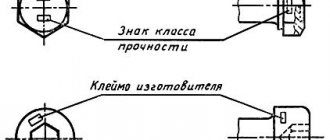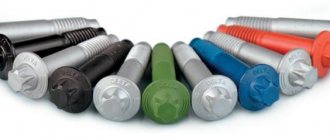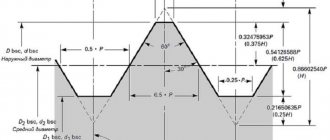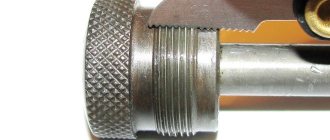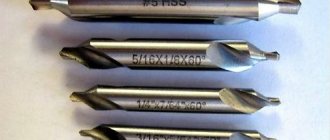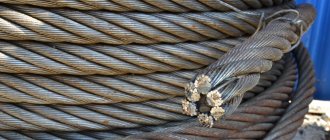Each bolt manufactured according to established standards is marked:
- Brand mark of the manufacturer.
- Product strength class.
- Left-hand thread sign (if necessary).
The strength class consists of two numbers separated by a dot:
- 1 - temporary resistance, measured in N/mm2.
- 2 is the ratio of the ultimate yield relative to its tensile strength, measured as a percentage. The yield strength is the ultimate load; after it is exceeded, irreversible deformation of the part will occur.
For example, marking 9.8 means:
- 9Х100=900 N/mm2 - temporary resistance.
- 9Х8х10=720 N/mm2 - yield strength.
All bolts with a strength of at least 800 N/mm2, according to the international classification, are usually classified as a high-strength group. This means that all products marked 8.8 and higher belong to the high-strength group.
Bolt strength classes and markings - table
The strength class of a bolt is a technical and operational characteristic that reflects the maximum load on a metal product when fastening parts, shows resistance to deformation, impact and rupture.
Strength classes reflect the maximum load when fastening parts.
According to GOST 1759.4-87 (ISO 898.1-78), hardware is divided into 11 groups: 3.6; 4.6; 4.8; 5.6; 5.8; 6.6; 6.8; 8.8; 9.8; 10.9; 12.9.
The higher the value, the greater the force the fastener can withstand, the stronger and more durable it is.
Categories from 3.6 to 6.8 include bolts intended for use in lightweight structures, 8.8-12.9 are highly reliable.
The mechanical properties of fasteners depending on the strength indicator are presented in the table below:
| Strength class | Nominal tensile strength, N/mm² | Vickers hardness (min/max), HV | Yield strength (min/max), MPa |
| 3.6 | 300 | 95/250 | 180/190 |
| 4.6 | 400 | 120/250 | 240 |
| 4.8 | 400 | 130/250 | 320/340 |
| 5.6 | 500 | 155/250 | 300 |
| 5.8 | 500 | 160/250 | 400/420 |
| 6.6 | 600 | 190/250 | 360/480 |
| 6.8 | 600 | 190/250 | 640 |
| 8.8 | 800 | 250/335 | 640/660 |
| 9.8 | 900 | 290/360 | 720 |
| 10.9 | 1000 | 320/380 | 900/940 |
| 12.9 | 1200 | 385/435 | 1080/1100 |
What is put on the bolt head?
There is a marking on a standard bolt made according to GOST 7798-70.
It includes:
- Strength class. Determines the degree of load and scope of application.
- Manufacturer's mark. Allows you to identify a company engaged in the production of hardware.
- Arrow. Indicates left-handed threads.
Standard location of markings on bolts
Designations are applied to the top of the head. They are convex and recessed. The geometry is determined by the manufacturer.
On bolts and screws with a diameter of more than 6 mm, marking is required. Smaller fasteners do not have a number.
A standard bolt is marked with a strength class.
On parts of small size or non-standard shape, symbols from the dial system are used.
Interpretation of signs on stainless metal bolts:
- Designation of austenitic steel grade:
- A2 – resistance to water;
- A4 – resistance to salts, alkalis, acids.
- The strength limit is 50, 60, 80, which corresponds to 500, 600, 800 MPa and classes 5.6(8), 6.6(8), 8.8.
Possibly a factory mark.
Products made from a martensitic alloy are marked similarly to carbon alloys, with the numbers at the bottom underlined. The standard allows not to put a period in the designation.
In BVP, signs are indicated in accordance with GOST 52644-2006.
As an example: D 11.14 8.8 S HL, where:
- D – manufacturer identifier;
- 11.14 – heat number;
- 8.8 – strength limit;
- S – bolt with a 6-sided enlarged head;
- “HL” – climatic version (cold region).
Products made of martensitic alloy have a factory mark.
Symbols are applied to studs if the thread diameter exceeds 12 mm.
Requirements according to GOST
Hardware must comply with the dimensions, mechanical properties, accuracy class, quality standards prescribed in GOST standards, and be free from major defects and traces of corrosion.
On drawings and specifications, engineers mark bolts strictly according to the standard.
What are kilonewtons
The minimum destructive loads for bolts are external negative forces that can provoke irreversible deformation processes in the connection. The unit of force is the Newton (N), which approximately corresponds to a mass of 0.1 kg. Thus, 1KN (1000 N) can be compared to a mass of 100 kg. If in the table “Break loads for bolts” for a fastener with M10 thread and strength class 6.8, a minimum breaking load of 34.8 KN is indicated, this means that this hardware is capable of withstanding a static load of up to 34.8 * 100 = 3480 kg or 3, 48 tons.
What is yield strength and how to determine it
The yield strength σт is the critical load on a detachable connection, at which an irreversible process of destruction of the structure occurs without increasing the acting force.
The parameter is affected by temperature. As it increases, σt decreases.
There are 2 formulas to calculate the indicator:
- For temporary tensile strength: the 1st digit in the designation of the strength class is multiplied by 100, then multiplied by the 2nd digit, the result is divided by 10. So, for hardware of group 5.8 σt=400 MPa (5x100x8:10=400).
- By strength class: the 1st and 2nd digits are multiplied by each other, then by 10. For category 5.8: σt=400 MPa (5x8x10=400).
The yield strength is the critical load on a detachable joint.
The higher the yield strength, the longer the part is able to remain in a state of tension and resist dynamic and stationary forces. When selecting fasteners, a 2- or 3-fold safety factor is taken into account.
What is the table for?
When developing and implementing threaded connections for structures and parts, it is important to achieve the optimal combination of strength, standard size and cost of fasteners. It is not advisable to install an overly large or extremely strong expensive bolt, which will certainly form an extremely reliable and durable connection, but will significantly increase the weight or cost of the connecting assembly.
It is the table that allows you to select fasteners that best combine the desired resistance to destruction, compact size and reasonable cost.
Strength class and steel grade
The quality of products is affected by the carbon content in the alloy. With a decrease in the amount of substance, the reliability, hardness and strength of the part increase.
Bolts are produced:
- low strength - from St. 10, 20;
- medium - from steel up to 0.4% carbon (U4);
- high - from structural low-, medium-carbon and alloy steels with strengthening additives.
The necessary properties are achieved as a result of heat treatment (hardening) in electric furnaces. The hardened alloy has high performance characteristics.
The most common grades for the manufacture of BVP are St30KhGSA; St35; St35X; St35HGSA; St38ХА; St40X; St40X "Select"; St20G2R.
How to understand how strong a nut is?
Unlike bolts, nuts have a single number for their strength. There are 6 nut strength classes in total: 4, 5, 6, 8, 10, 12. What do these numbers mean? Simply put, this number corresponds to the first number in the marking of those bolts with which this nut can be used. For example, a grade 8 or 8.0 nut is used with grade 8.8 bolts, and a grade 6 nut is used with grade 6.6 or 6.8 bolts.
In critical structures, stainless steel bolts are used. Their markings display the ultimate tensile strength in kgf/mm2 (1 kilogram-force ≈ 9.807 newtons). Only three values of this indicator are used: 50, 70 and 80. In addition, the steel grade is included in the markings. Thus, a stainless steel bolt marked A2-80 is made of stainless austenitic steel A2 with an ultimate tensile strength of 80 kgf/mm2 or approximately 785 N/mm2
Strength of highly specialized bolts
Separate standards and requirements are provided for BVP for narrow industry purposes. Fasteners are made enlarged.
The characteristic that determines the strength of a metal is the stress corresponding to the maximum force and preceding rupture.
The group of specialized BVPs includes bridge bolts, shoe bolts, anchor bolts, railway bolts, etc.
Some of them are designed for use in difficult and extreme conditions and are marked:
- “HL” – for harsh climates with temperatures down to -60°C;
- “U” – for areas with an average cold (moderate) regime down to -40°C.
Mechanical properties are specified in GOST 22353-77, R 52644-2006, 24379.1-80.
Operation of High Strength Bolts (Spheres, Areas and Examples)
The use of high-strength bolts is often found in such areas as construction, road equipment manufacturing, instrument and mechanical engineering, as well as other production-related areas. The high demand for them is due to the fact that such hardware has practically no restrictions on use and is used in toxic aggressive environments and at low temperatures (down to −60C).
High-strength fasteners can withstand both constant and variable loads, with a moving center of gravity, and even strong vibrations. Therefore, with the help of these hardware, buildings are built, industrial equipment, heavy equipment (including military) and special purpose vehicles (cranes, loaders, etc.) are manufactured.
Types of bolt fastening
Threaded connections are structurally different from each other.
Bolted
A bolt is a part equipped with a head and threads at different ends. The thread is necessary to screw on the nut. The head is picked up from the outside with a wrench.
To install hardware, holes of larger diameter are drilled on the surfaces to be joined. The end side is chamfered.
The bolted fastening is easy to replace if broken.
The disadvantage of the connection is that it requires a lot of space, which leads to an increase in the size and weight of the structure.
Advantage: easy replacement if broken.
Screw
The screw is screwed into the housing using a special end tool. The head comes in different shapes, including 6-sided. The main difference is the small installation area.
Negative point: during installation, the thread is often damaged, and it is difficult to remove part of the fastener. Therefore, screw connections are not used for repeated installation/disassembly.
Using studs
A stud is a cylindrical fastener without a head, the ends of which have threads of the same diameter. There is a tight cut on one side. The other end is needed to install the nut.
Fastening with studs is required for frequent assembly of the structure.
The element is in demand for frequent assembly/disassembly of the structure and installation in hard-to-reach places. The stud may bend and lose strength. The thread often breaks due to heavy loads.
Rules for installing high-strength bolts
Before starting work, a preliminary analysis of the technical operating conditions of the future structure is always carried out. The selection of the required hardware will be influenced by the following factors:
- Characteristics of additional accessories.
- Twist factor.
- Correspondence of the technical and mechanical properties of the hardware to the environment in which it will work.
- Resistance to various external influences.
- Properties of the steel from which it is made.
- Thread pitch and type.
The conditions for the correct choice are also influenced by the size, shape of the bolt head, the presence of heat treatment and protective coating. Always start from the purposes for which you need hardware. The further procedure is as follows:
- The holes in the connected elements are aligned and the elements are rigidly secured using assembly plugs. Usually a tenth of the holes are secured with plugs - this is quite enough for reliable fixation.
- High-strength bolts are inserted into the holes free of plugs and tensioned in accordance with the rules and with the force specified in the technical documents.
- Then remove the assembly plugs, install the remaining bolts and tighten all the parts to the design strength. After this, the working surface can be primed.
Use a calibration wrench that allows you to control and adjust the tension of the bolts.
Connecting bolts using threads
Thread classification:
- metric;
- inch;
- cylindrical pipe;
- conical;
- rectangular;
- trapezoidal;
- persistent;
- standardized round.
Metric thread is the main type of threaded connection. Its parameters are the nominal diameter and thread pitch in millimeters, established by GOST 8724-81.
Connecting bolts using threads is reliable and technologically advanced.
Advantages:
- reliability;
- multifunctionality;
- manufacturability;
- the ability to adjust the compression force;
- availability of a wide range of products.
Disadvantage: tendency to self-unscrew.
Technological production of bolts
There are two fundamentally different methods for manufacturing this type of fastener:
- Turning is the process of making bolts individually or in small batches from a steel bar on a screw-cutting lathe.
- Cold or hot stamping in a factory followed by thread rolling.
The bolt manufacturing process, regardless of the method, consists of the following steps:
- Preparing a metal rod (wire rod).
- Cutting workpieces to the required length.
- Making a chamfer at the end of the stud.
- Bolt head shaping.
- Thread cutting.
Quality control is carried out at all stages of production. When manufacturing hardware according to an individual drawing, the first manufactured part is checked with the most careful control. If deviations from the technical specifications are detected, the bolt manufacturing process should be reviewed and the cause of the discrepancy should be found.
Manufacturing on a screw-cutting lathe
The stages and methods of processing a workpiece depend on the type of source material (hexagonal or cylindrical rod, characteristics of the metal), as well as on the degree of accuracy of the workpiece. Hot-rolled blanks have less accuracy, which eliminates the possibility of precise centering of the future part on a turret lathe or on a CNC machine.
The technological process of manufacturing a bolt part on a lathe from a cold-drawn hexagonal rod is divided into several stages:
- A workpiece of the required length is cut from a steel bar using a hacksaw.
- The workpiece is fixed in a hexagonal collet so that the head of the part does not mix relative to the central axis of the future bolt.
- Trimming the end of the bar to size, centering it on a screw-cutting lathe.
- Grinding the workpiece to obtain the specified dimensions, chamfering using cutters.
- Cutting threads using a die or thread cutter.
- Grinding the bolt head, chamfering.
- Machining the head with a milling cutter.
If there are special requirements for the hexagon of the head of the part, the technical process of manufacturing the bolt on a lathe becomes more complicated. To prevent displacement of the head axis relative to the cylinder axis, the workpiece is subjected to additional processing.
Manufacturing of bolts by cold stamping
The first stage of the technical process is preparing the metal for the stamping process:
- The surface of the workpiece should be smooth and shiny. Surface cleaning under production conditions is performed mechanically or by calcination.
- Cleaning is carried out to remove scale and grease.
- Lubricating the surface of the workpiece (the surface of the metal is first coated with a lubricating layer; this is mandatory before drawing).
Scale from the surface of metal workpieces is usually removed by etching. To do this, the rod is immersed in a solution of sulfuric or hydrochloric acid of a certain concentration for a period of 5 minutes to half an hour. To eliminate pickling sludge, the workpieces are washed in hot water. If the etching was carried out using a sulfuric acid solution, the residues are washed off and neutralized by liming the rod.
The production of bolts from a metal rod occurs without heating the metal. The deformation of the workpiece during cold stamping is accompanied by cold hardening—an increase in the mechanical strength of the metal. The finished part is obtained by filling a standard die of a given configuration with the workpiece material. Next, the part is upset—the finished metal hardware is removed from the die.
Advantages of the cold stamping method in the production of bolts:
- High level of process productivity.
- Maximum surface cleanliness of parts and dimensional accuracy.
- Manufacturing of bolts with a core diameter of up to 52 mm.
When choosing a cold stamping method, you should take into account the ratio of the size of the head and the diameter of the rod of the part, as well as the ratio of the diameter of the head to its height and indicators of relative and true deformation. If the ratios for the listed quantities are higher than the critical values, the possibility of manufacturing the part by hot stamping should be considered.
Manufacturing of bolts by hot stamping
The essence of hot stamping is the precipitation of metal and its redistribution from the middle to the edges of the die. If stamping occurs in open dies, a metal burr (burr) is formed. Stamping in closed dies is called flashless. The manufacturing process of a bolt part using hot stamping begins with cleaning and cutting the workpieces. Then the blanks go through a full cycle of operations to transform them into durable and reliable fasteners:
- Heating up to 1000 degrees using an inductor.
- Forming the head of a part using an impact press.
- Chamfering on a milling machine.
- Thread cutting on an automatic machine.
To ensure high corrosion resistance of the fasteners, the bolts are galvanized. Coating stages:
- Washing parts in hot water.
- Chemical cleaning of the surface from metal oxides by etching in hydrochloric acid.
- Neutralize remaining acid by repeated rinsing with water.
- Immersion of parts in a zinc solution heated to a temperature of 450 degrees.
In chemical galvanization, a layer of zinc is deposited on the part in an electrolyte solution. The finished bolts are polished and mechanical defects are eliminated.
Hot stamping provides high strength characteristics of finished hardware. This primarily concerns stamping in closed dies. The increased strength is explained by the fact that the fibers, oriented according to the shape of the stamp contour, are not cut off along with the burr (flare-free stamping).
Application area
High-strength bolted connections are designed for the installation of complex building structures that will be subject to:
- high temperature changes;
- precipitation;
- strong and frequent winds;
- contact with chemicals.
Since the dimensions of fasteners provided for by GOST vary, the scope of application of hardware is extensive:
- machines, equipment;
- agricultural machinery, mechanical engineering;
- construction of bridges, buildings;
- shipbuilding;
- industry, production.
Friction connection with high-strength bolts perfectly copes with the task of strong and reliable installation of structures subject to dynamic loads and vibrations.
This fastener is widely used in everyday life. It is ideal for renovating apartments and balconies; it will securely fasten any structures to concrete walls. Car enthusiasts cannot do without such bolts when repairing their car, especially wheel fastenings.
Dimensions
The dimensions of high-strength bolted connections exactly correspond to GOST 52644 standards:
- Diameter of hardware in ascending order: from bolt M10 (smaller) to M48 (larger).
- Length from 40 to 300 mm.
- The weight of 1000 pieces depends on the diameter and length. It can be determined from the corresponding tables according to GOST. The mass of M16 fasteners, for example, will be 115-515 kg, M20 - 200-800 kg, and M48 - from 2500 to 5000 kg.
- The thickness of the additional coating is also regulated by GOST, depending on the diameter of the hardware. Thus, high-strength bolts M24 have a coating thickness of 40 microns, and M16 - 25 microns.
